Virtual reality filmmaking is changing how we watch movies. It offers an immersive and interactive experience. Viewers can look around in 360 degrees, unlike traditional films.
This technology has grown a lot in the last few years. Famous directors are now making VR films. They mix storytelling with new tech.
Immersive storytelling is key in VR filmmaking. It uses special audio and imaging to improve the experience. People want wireless headsets for better comfort and ease of use.
As VR grows, we’ll see more new uses in films. This includes VR cinema for exciting new experiences.
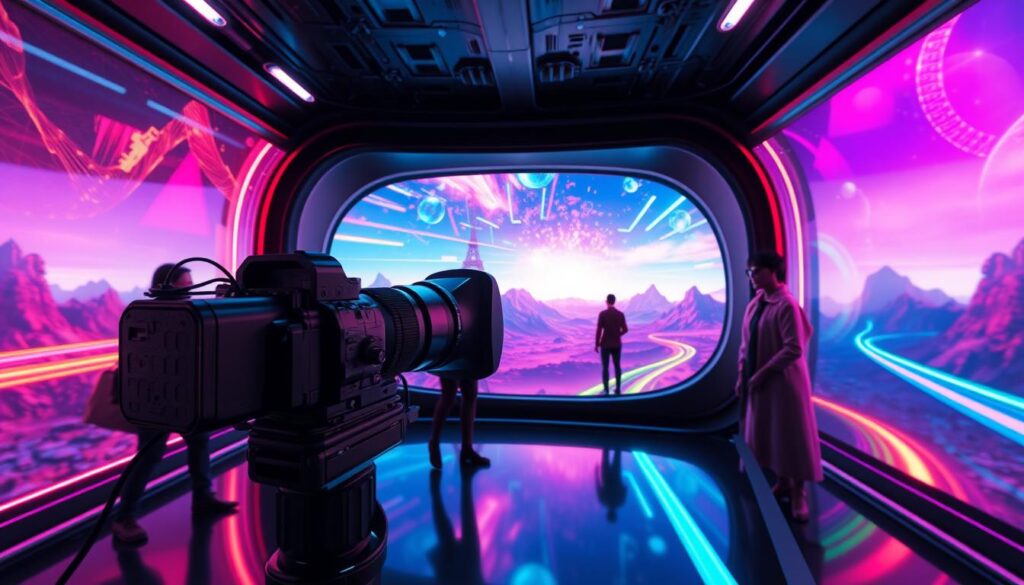
VR cinema is getting more exciting by the day. New tech and methods are being tried all the time. From live images to 3D effects, the possibilities are endless.
We’ll look into what makes VR filmmaking work. This includes the tech behind it and the gear needed.
Key Takeaways
- Virtual reality filmmaking provides an immersive and interactive experience for audiences
- Cine-VR allows viewers to look around in 360 degrees, creating a distinct experience from traditional film
- Immersive storytelling is at the heart of virtual reality filmmaking, with techniques such as stereoscopic imaging and ambisonics for 360-degree audio
- The increasing demand for wireless head-mounted displays is noted, with these devices providing cost advantages and enhanced user comfort and portability
- VR cinema is an exciting and rapidly evolving field, with new technologies and techniques being developed all the time
- Virtual reality filmmaking has the ability to transform the film industry, bringing new and thrilling experiences to viewers
Understanding Film in Virtual Reality
Virtual reality (VR) is changing the film world, bringing new ways to see and interact with stories. Immersive cinema is getting more popular, with the VR market expected to grow a lot in the future. This growth comes from better VR tech and more people wanting to dive into immersive experiences.
VR film making means creating stories that you can step into and feel part of. Virtual reality storytelling needs a deep understanding of VR and how to tell stories that use its special features. As VR tech gets better, we’ll see even more exciting VR stories.
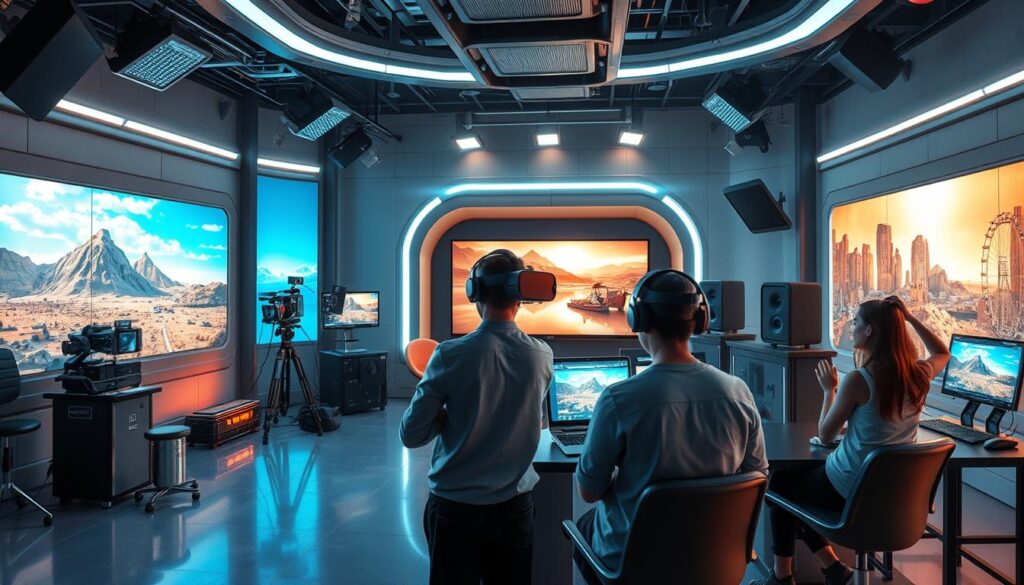
The world of virtual cinema is growing with VR tech. As VR headsets get cheaper and easier to find, we’ll see more VR content wanted. This opens up new chances for filmmakers to try immersive cinema and explore what VR can do.
The Technical Foundation of VR Cinema
VR technology has changed the film world, making movies more real for viewers. Filmmakers use special gear to make a world that feels real. About 90% of VR users wear headsets that let them see, hear, and feel the action.
VR and movies are just starting to mix, with 60% of filmmakers wanting to try VR. But making a VR movie costs more, up to five times more than a regular film. Yet, over 80% of people say VR makes stories feel more real than regular movies.
VR cinema has cool features like:
- Immersive storytelling, which lets viewers dive deeper into the story
- Interactive elements, where viewers can shape the story
- 360-degree viewing, for a full, immersive view
As VR tech gets better, we’ll see even more cool uses in movies. VR could make movies up to 40% more engaging than usual. This makes VR cinema an exciting and fast-growing field.

| Feature | Description |
|---|---|
| Immersive storytelling | Allows viewers to engage with the story on a deeper level |
| Interactive elements | Enable viewers to influence the narrative |
| 360-degree viewing | Provides a unique and immersive visual experience |
Essential Equipment for VR Filmmaking
To make virtual reality films, you need special gear. The right tools can make your film look amazing. High-quality VR cameras like the GoPro MAX or Insta360 One X2 are key. They let you capture 360-degree footage.
Audio recording equipment is also vital for great sound. Tools like the Sennheiser AMBEO VR Mic offer directional sound. You can also use lavalier or shotgun microphones for clear audio.
After filming, you’ll use post-production software to edit. Adobe Premiere Pro, Final Cut Pro X, and Kolor Autopano Video are popular choices. They help you stitch 360-degree videos together for a seamless experience.
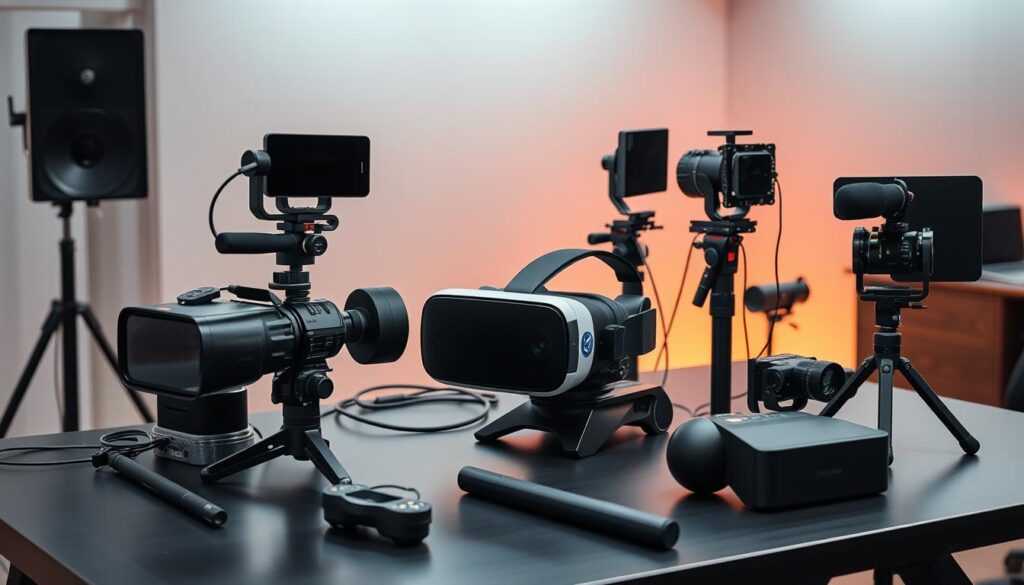
| Equipment | Description |
|---|---|
| VR Cameras | GoPro MAX, Insta360 One X2, Ricoh Theta V |
| Audio Recording Equipment | Sennheiser AMBEO VR Mic, lavalier microphones, shotgun microphones |
| Post-Production Software | Adobe Premiere Pro, Final Cut Pro X, Kolor Autopano Video |
With the right gear, filmmakers can make VR films that pull viewers in.
Storytelling in Virtual Reality
Virtual reality (VR) is changing how we enjoy stories. 90% of users feel like they’re right in the story. This makes them connect more with characters, with 70% feeling a stronger bond than with regular media.
Interactive stories can make users more involved by up to 50%. Immersive storytelling in VR also increases empathy by 70%. Users get to see stories from the characters’ eyes. VR also helps in learning, with a 30% better retention of knowledge than usual teaching methods.
Some key benefits of VR storytelling include:
- Increased emotional connection to characters
- Improved empathy and understanding of complex social issues
- Enhanced engagement and participation in educational settings
- Boosted knowledge retention and comprehension
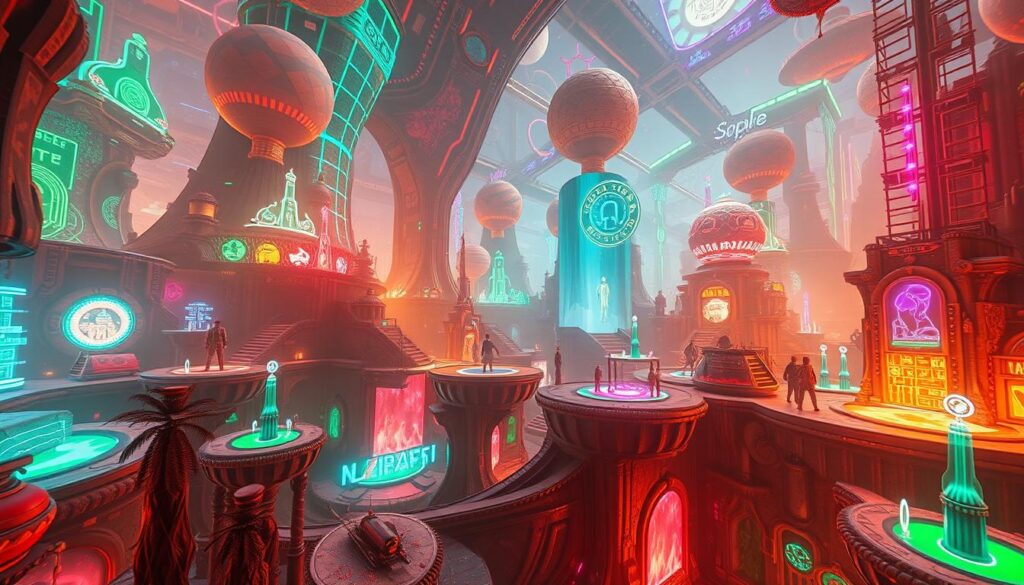
The demand for VR storytelling is rising fast, with a 34% growth rate from 2023 to 2030. It’s becoming key in both entertainment and education. Thanks to interactive film and immersive storytelling, we can make experiences more engaging and effective.
Directing for Virtual Reality Films
Directing virtual reality films is a unique challenge. It requires skills in VR directing, which means knowing how to guide the viewer’s attention in a 360-degree space. The placement of the camera is key, as it affects the viewer’s experience. By placing the camera wisely, directors can make the viewer feel immersed and control the story’s flow.
It’s also important to manage viewer attention in VR filmmaking. Directors need to keep the viewer engaged and focused on the story. This can be done by planning camera movements and using visual cues to guide the viewer’s attention.
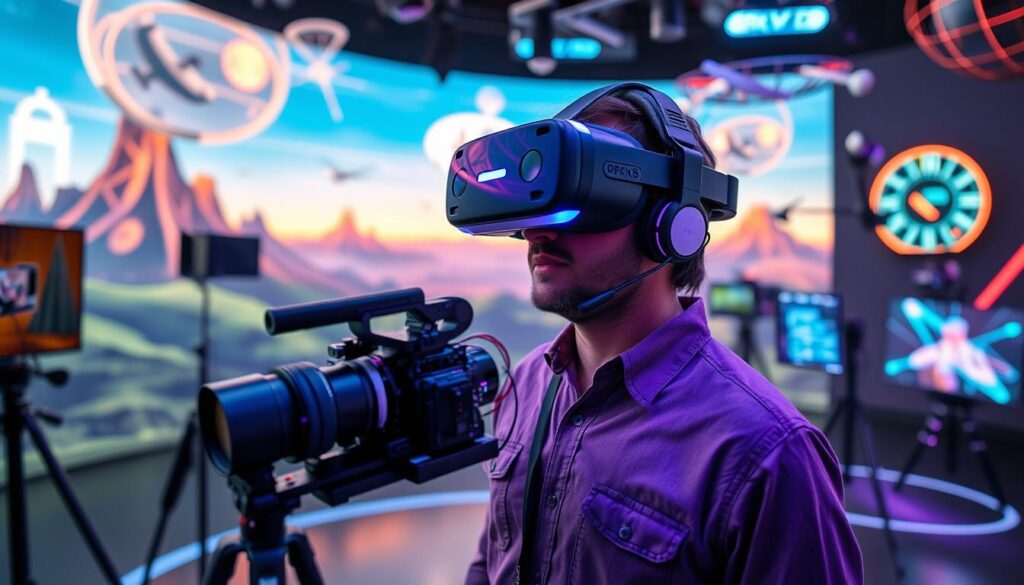
- Use camera placement to create a sense of intimacy or distance
- Control viewer attention through careful planning of camera movement and visual cues
- Experiment with different VR directing techniques to find what works best for your story
By using these tips and understanding the challenges of VR directing, filmmakers can create immersive and engaging experiences. These experiences draw the viewer in and keep them invested in the story.
| VR Directing Techniques | Description |
|---|---|
| Camera Placement | Strategic placement of the camera to control the viewer’s attention |
| Camera Movement | Use of camera movement to guide the viewer’s attention and create a sense of immersion |
| Visual Cues | Use of visual cues to guide the viewer’s attention and control the flow of the narrative |
The Role of Sound in VR Cinema
Sound is key in virtual reality movies, making the experience feel real. VR audio mimics how we hear in real life, adding depth to the virtual world. Sound engineer Martin Rieger says music in VR is important, and 3D audio is vital for a full experience.
Creating great VR audio involves head tracking and 6 Degrees of Freedom (6 DoF). These features let viewers move and hear sounds from all sides. VR platforms like Oculus and HTC Vive support immersive sound. Unity3D and Unreal Engine also have tools for 3D audio.

Filmmakers need to focus on the technical side of audio production. This includes recording, editing, and mixing. By doing this, they can make an experience that feels like you’re right there in the film. As VR tech gets better, the role of VR audio and 3D audio will grow, opening up new ways to tell stories.
Post-Production Workflow for VR Films
Virtual reality films need a special post-production process. It starts with stitching and editing. Here, different camera views are merged into a single 360-degree scene. This step is key to the film’s success.
Then, color grading is applied to improve the film’s look. It involves tweaking colors, contrast, and brightness. This makes the scene feel more real and engaging.
Some important tools for VR post-production are:
- Unreal Engine
- Unity
- Adobe Premiere Pro
These tools help in editing 360° content. They also make it easier for teams to work together. This leads to better sound design in VR films.
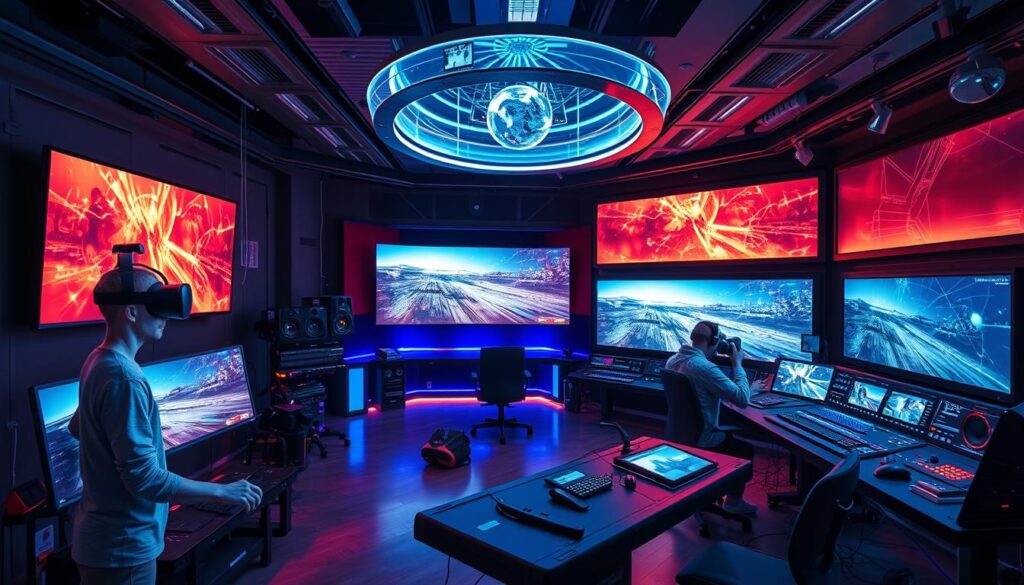
Visual effects and graphics add to VR films. They let filmmakers create things that can’t be shot live. This opens up new ways to tell stories and engage viewers.
| Tool | Description |
|---|---|
| Unreal Engine | A game engine used for creating photorealistic scenes |
| Unity | A game engine used for creating complex animations |
| Adobe Premiere Pro | A video editing software used for stitching and editing |
Distribution Platforms for Virtual Reality Films
Virtual reality films can be shared through many platforms. These include film festivals, online sites, and VR theaters. Immersive film distribution is key to reaching more people and boosting VR content. Film festivals are very important for showing VR films and helping creators meet their audience.
Popular virtual reality platforms for VR films are Oculus Rift, Oculus/Samsung GearVR, and Google Daydream. These platforms have tools and features for creators to share their work. Online sites like YouTube and Vimeo also host VR content, though they might not offer the same experience as VR platforms.
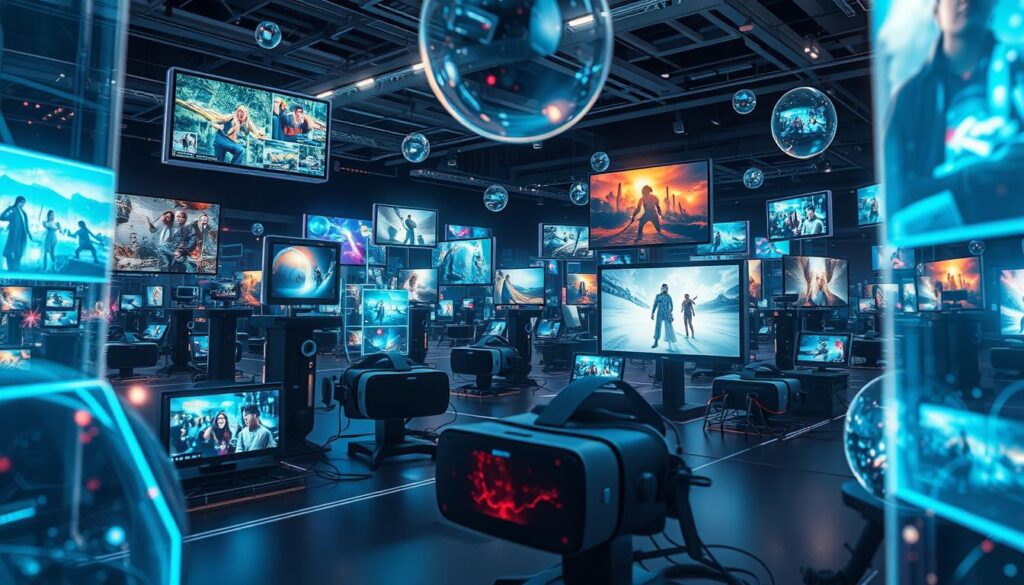
For immersive film distribution, creators must think about their content’s technical needs. For example, a 3-minute VR short film can be about 700MB. This shows how much bandwidth is needed for streaming. Despite these challenges, the need for VR content is rising. Creators are finding new ways to share their work and connect with viewers.
Challenges in VR Filmmaking
Virtual reality filmmaking comes with its own set of challenges. One big issue is the technical limits of VR gear. For example, high-end 360 cameras often struggle in low light, leading to grainy footage. Filmmakers also face creative hurdles, like guiding the viewer’s attention with lighting and sound, not just cuts.
Some of the key VR challenges include:
- Technical limitations, such as equipment constraints and software inconsistencies
- Creative obstacles, such as guiding viewer attention and creating immersive narratives
- Budget considerations, such as the cost of high-end equipment and post-production software
Despite these hurdles, many filmmakers are finding new ways to tackle them. Tools like the Neat Video plugin help with noise reduction. The Facebook360 plugin makes managing audio easier across different platforms. By tackling these VR challenges, filmmakers can make engaging, high-quality experiences that showcase the medium’s unique features.
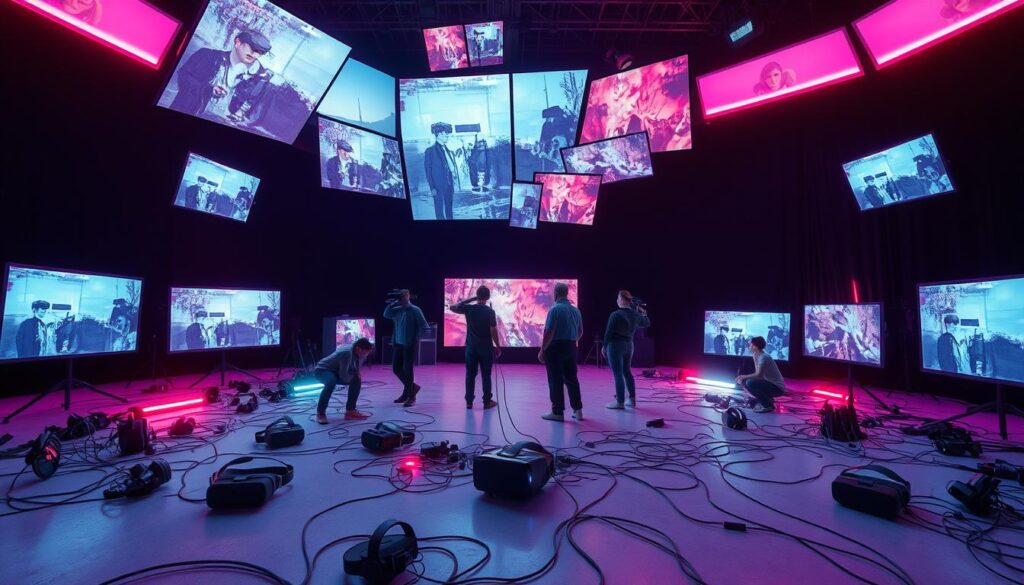
By accepting the technical and creative challenges of VR filmmaking, filmmakers can explore new possibilities. As the field grows, it will be fascinating to see how they adapt and innovate to meet these challenges.
Best Practices for VR Film Production
Creating top-notch immersive filmmaking experiences requires following VR best practices. In film production, it’s key to think about the viewer’s comfort and view. For example, the best camera height for VR filming is between 62 and 66 inches. The overlap area in 360-degree stereoscopic views is called the “sweet spot” for the best 3D visuals.
Some important things to keep in mind for VR film production are:
- Make sure the camera is perfectly level to avoid disorientation
- Keep all camera movements steady to prevent distracting or nauseating footage
- Place action in the center of the frame for clear and comfortable shots
By sticking to these VR best practices and understanding immersive filmmaking, filmmakers can make engaging and comfortable experiences. As the VR world grows, it’s vital to keep up with new film production methods and tech for the best results.
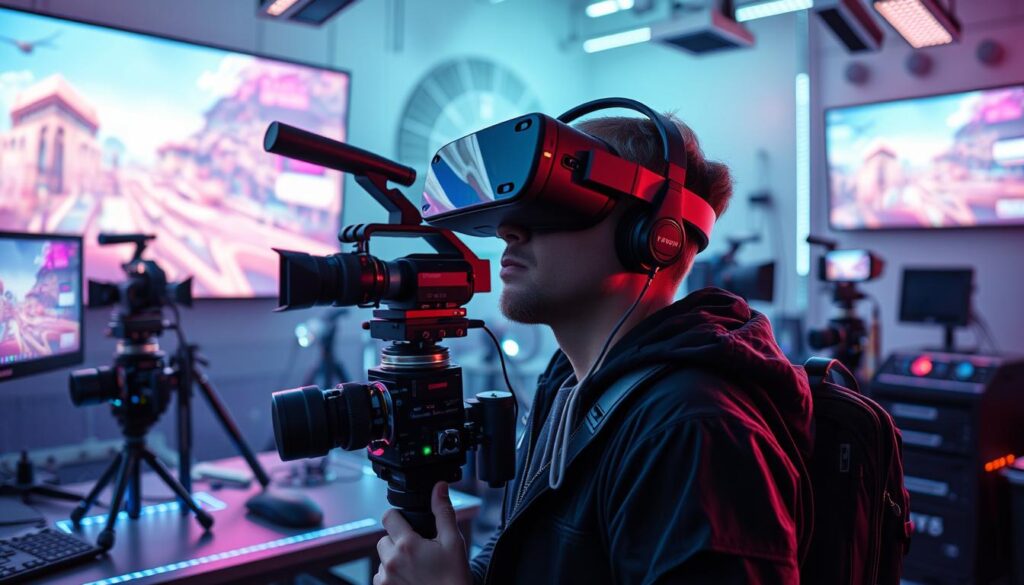
| Aspect of VR Filmmaking | Best Practice |
|---|---|
| Camera Height | Between 62 inches and 66 inches |
| Camera Movement | Stabilized and smooth |
| Action Positioning | Centered in the frame |
The Future of Virtual Reality in Cinema
The VR future is looking bright, with emerging technologies changing how we watch movies. Virtual reality cinemas are becoming more popular. They offer a fully immersive experience with VR headsets and motion chairs.
These cinemas have cool features like unlimited 360-degree rotation and vertical tilt. They even offer sensory experiences like wind and scents. Tickets cost about $20, and films last from 5 to 37 minutes.
The market for Virtual Reality in cinema is growing fast. It’s expected to grow at a compound annual growth rate of about 33.5% from 2021 to 2028. By 2025, the global VR market in entertainment, including cinema, is expected to hit around $45 billion.

- The VR market is expected to reach $45 billion by 2025.
- The market is growing at a compound annual growth rate of 33.5%.
- 72% of film industry professionals believe VR will become a standard form of film distribution within the next decade.
| Year | VR Market Size | Growth Rate |
|---|---|---|
| 2021 | $10 billion | 20% |
| 2025 | $45 billion | 33.5% |
The future of virtual reality in cinema is exciting. New technologies and innovations are coming out every day. As the market grows, we’ll see more immersive and interactive experiences. These will change how we watch movies.
Success Stories in VR Filmmaking
Virtual reality filmmaking has grown a lot in recent years. Many VR success stories have come out in the industry. For example, Jon Favreau’s “Gnomes & Goblins” is a short VR experience. It’s available on HTC Vive and will soon be on Oculus Rift.
This project shows how VR can offer new ways to watch movies. The VR industry is young but promising. It has already brought us many virtual reality filmmaking successes.
These successes have changed how we tell stories. They’ve also introduced new ways to show things on screen. For example, using real-time CGI in virtual reality makes interactions between actors and digital scenes better.
VR filmmaking has many benefits. It keeps viewers engaged for longer and can save money compared to old ways of making movies. As VR keeps getting better, we’ll see even more amazing immersive film experiences. It will be exciting to see how VR success stories change the film world.
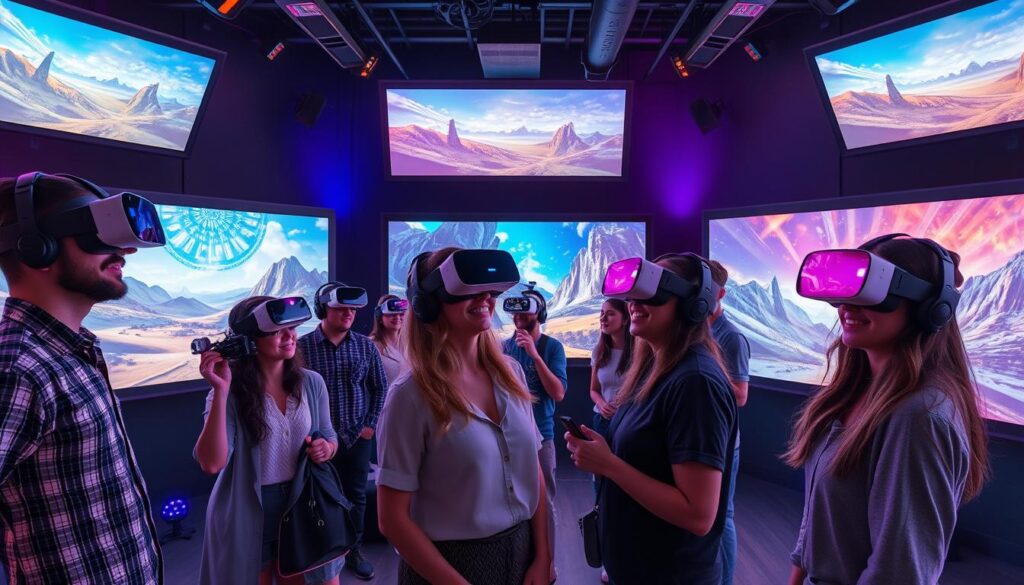
Here are some key takeaways from the current state of virtual reality filmmaking:
- Increased audience engagement and viewing time
- Potential to reduce production costs
- New cinematic techniques and story representation
- Improved visual storytelling with real-time CGI
| Project | Platform | Description |
|---|---|---|
| Gnomes & Goblins | HTC Vive, Oculus Rift | Interactive 360-degree VR experience |
Conclusion
Virtual reality (VR) is changing filmmaking, bringing us a new way to tell stories. Movies like “The Lion King” remake and VR experiences from “Westworld” and “Game of Thrones” show how VR is changing the game. It lets us step into digital worlds like never before.
Now, we’re moving from just watching movies to being part of them. New tech like LED Volume and VR hardware lets filmmakers create real-time digital worlds. This makes it hard to tell what’s real and what’s not.
The future of VR in movies looks bright. It could make movies cheaper to make, more engaging for viewers, and open up new ways to tell stories. As VR, AR, and AI get better, we’ll see even more amazing movies.
The adventure in virtual reality filmmaking is just starting. With endless possibilities, the future of movies is exciting. It will bring us new kinds of magic that will amaze and inspire us for years to come.
FAQ
What is virtual reality in film?
Virtual reality (VR) in film uses technology to make movies more interactive and fun. It uses VR headsets and 360-degree cameras. This way, viewers feel like they’re part of the story.
How does VR filmmaking differ from traditional filmmaking?
VR filmmaking is different because it uses 360-degree cameras and focuses on interactive stories. It also needs to keep the viewer’s attention in all directions.
What equipment is needed for VR filmmaking?
You need VR cameras, audio tools, and special software for VR filmmaking. This software helps with editing and color correction.
How do filmmakers approach storytelling in VR?
VR stories are interactive and immersive. The audience helps shape the story. Filmmakers must keep the viewer’s attention in a 360-degree world.
What are the challenges of directing for VR films?
Directing VR films is hard because of camera placement and keeping the viewer’s focus. It’s also about creating stories that pull the audience in.
How important is sound in VR cinema?
Sound is key in VR cinema. It makes the experience feel real and enhances the visuals. Filmmakers use 3D audio to blend sound with visuals.
What is the post-production workflow for VR films?
Post-production for VR films involves editing, color grading, and adding effects. It makes the experience smooth and immersive.
How can VR films be distributed and accessed by audiences?
VR films can be shown at festivals, online, or in VR theaters. Each way has its own benefits and challenges.
What are the common challenges faced by VR filmmakers?
VR filmmakers face tech limits, creative hurdles, and budget issues. Overcoming these is key to making great VR films.
What are the best practices for VR film production?
Good VR production starts with planning, testing, and a solid post-production process. This ensures a smooth and engaging experience.
What is the future of virtual reality in cinema?
The future of VR in cinema looks bright. New tech and trends could change how we watch movies.
Can you provide examples of successful VR films?
“Notes on Blindness,” “Clouds over Sidra,” and “The Line” are great VR films. They show VR’s power to engage audiences.